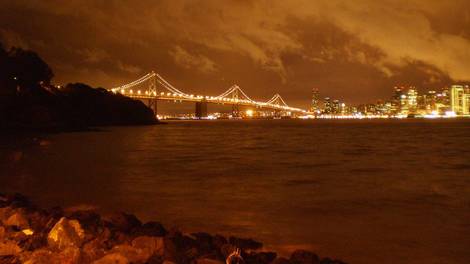
Special Issue
CRASE
Bright Future or Cautionary Tale? How the Bay Area Shapes the Future of the U.S.
Climate Change, Sea Level Rise, and Urban Development in the San Francisco Bay Area

California appears to be at the vanguard in addressing climate change through policies that might reduce greenhouse gas (GHG) emissions, petroleum use, and energy consumption. However, the reality on the ground presents a different picture. For instance, one of the major effects of climate change that coastal cities across the world, and particularly in California, will have to deal with is sea level rise. While estimates of sea level rise vary significantly, some forecasts peg the number at 10 feet over the next 70 years! The important question then is: What is California—and the Bay Area—doing to address the effects of sea level rise on urban development?
Despite the warnings and perils associated with sea level rise, billions are being pumped into high-stakes, high-risk development planned on low-lying coastal sites. In the San Francisco Bay Area alone, a 2015 analysis by the Public Press found $21 billion invested in 27 waterfront projects planned at elevations less than 8 feet above the high tide line. One of the sites identified in the analysis, which my own research has examined in detail, is Treasure Island, located in the middle of San Francisco Bay. This low-lying, manmade, disconnected island site, of approximately 400 acres, could soon turn into a new San Francisco neighborhood. The City of San Francisco and its developers propose to build 8000 units of housing, two hotels, about 500,000 SF of commercial space, and 300 acres of parkland.
Proponents of building on low-lying coastal sites invariably bring up the example of the Netherlands. However, the Bay Area is very far from the kinds of measures the Dutch have taken where the threat from flooding is taken seriously and actually woven into the fabric of everyday life. For the Dutch it is not just about big gates and dams at the sea, but an entire philosophy that includes spatial planning, mobile apps, crisis management, and children’s education in which fifth graders are taught to swim with their clothes on.
In the Bay Area, questioning the viability of development on low-lying coastal sites is deeply unpopular because of the lack of housing in the region. This encourages local urban jurisdictions and developers, like in Florida for example, to take on high-risk projects with the promise of massive returns on investment. Construction has begun on Treasure Island with $1.4 billion being fronted up for infrastructure improvements before new housing is even built. This includes plans to raise the entire island and build a higher, stronger seawall. Yet there is little evidence—especially considering the example of Miami Beach, which is constantly inundated despite its massive seawalls and giant pumps—that such mitigation measures will actually succeed.
Indeed, limiting GHG emissions and petroleum use could decelerate the melting of the polar ice sheets and reduce the severe impacts of sea level rise. The City of San Francisco has also begun to take steps to address rising seas through The Sea Level Rise Action Plan. But, arguably, many of these steps are focused on ecosystems, green infrastructure, and habitat restoration—all good measures, but perhaps insufficient in tackling the amount of sea level rise we might actually witness. Climate “resilience, mitigation, and adaptation” strategies need to work at several levels—cutting back on energy use and emissions, and also limiting development in areas vulnerable to sea level rise.
The dissonance of California’s leadership on climate change is perhaps best exemplified in a moment on Treasure Island in December 2009 when former Governor Arnold Schwarzenegger marked the release of the California Climate Adaptation Strategy. Speaking in front of a map showing areas that might be inundated, his hand pointing at, and completely covering, Treasure Island, the former Governor declared, “Within a century, Treasure Island, this place where we are right now, could be totally under water.” Despite his own warning, the former Governor perhaps missed the irony that he was standing on a sinking island site, where a proposed development potentially risked billions of dollars, and lives. “It is technology in the end that will save us,” Schwarzenegger went on to proclaim, as though technology could serve as the positivistic solution to surmount climate change.
Since the early 2000s, California’s leadership in addressing climate change has been publicly lauded. In 2006, former Republican Governor, Arnold Schwarzenegger unveiled the California Global Warming Solutions Act, also known as (AB) 32, setting standards to limit GHG emissions to 1990 levels. In 2015 Democratic Governor Jerry Brown signed into law the Clean Energy and Pollution Reduction Act (SB 350) that reduces petroleum use to 50 percent by 2030, and requires a drastic reduction in energy use in homes, factories, and businesses. Following the Trump Administration’s withdrawal of the United States from the Paris Agreement, California decided to go on its own and took the lead in an unprecedented meeting that Governor Jerry Brown had with the Chinese premier Xi Jinping in June 2017 to discuss global climate policy. Nonetheless, if California is to truly lead on climate change, then its political leadership and policies will have to look more closely at the serious impacts sea level rise will have on urban development in the decades to come.
 Tanu Sankalia is Associate Professor and Program Director of the interdisciplinary program in Urban Studies at the University of San Francisco where he teaches courses in urban planning and design, architectural and urban history, and architectural design. He is the co-editor of Urban Reinventions: San Francisco’s Treasure Island published by the University of Hawaii Press, 2017.
Tanu Sankalia is Associate Professor and Program Director of the interdisciplinary program in Urban Studies at the University of San Francisco where he teaches courses in urban planning and design, architectural and urban history, and architectural design. He is the co-editor of Urban Reinventions: San Francisco’s Treasure Island published by the University of Hawaii Press, 2017.
